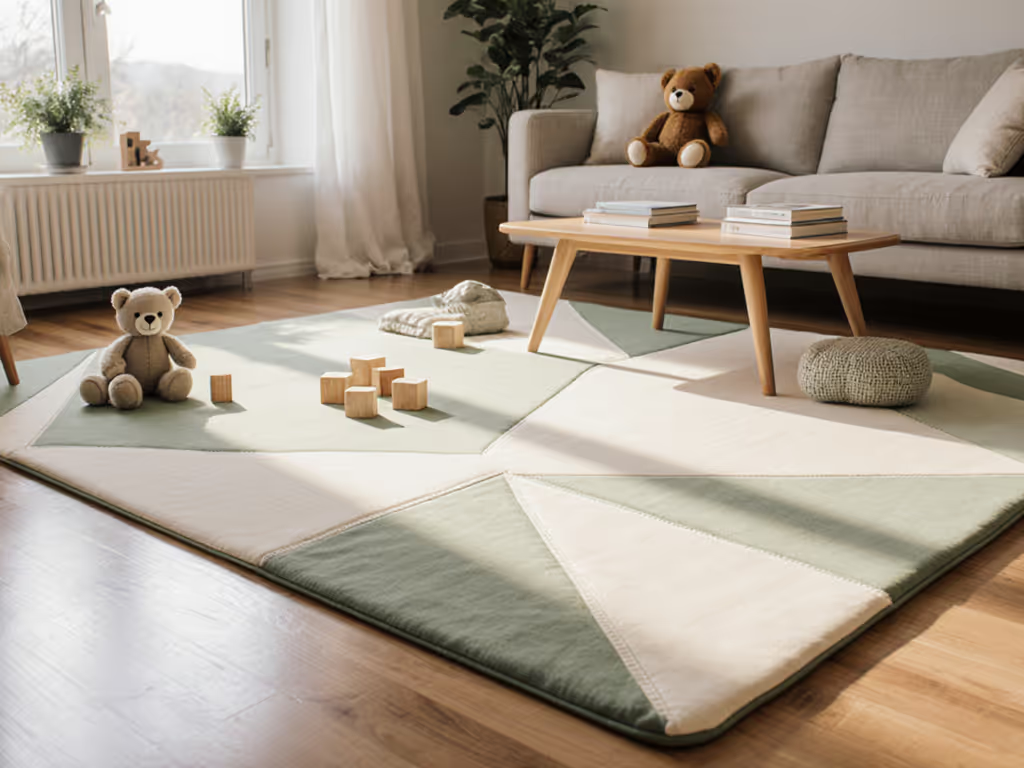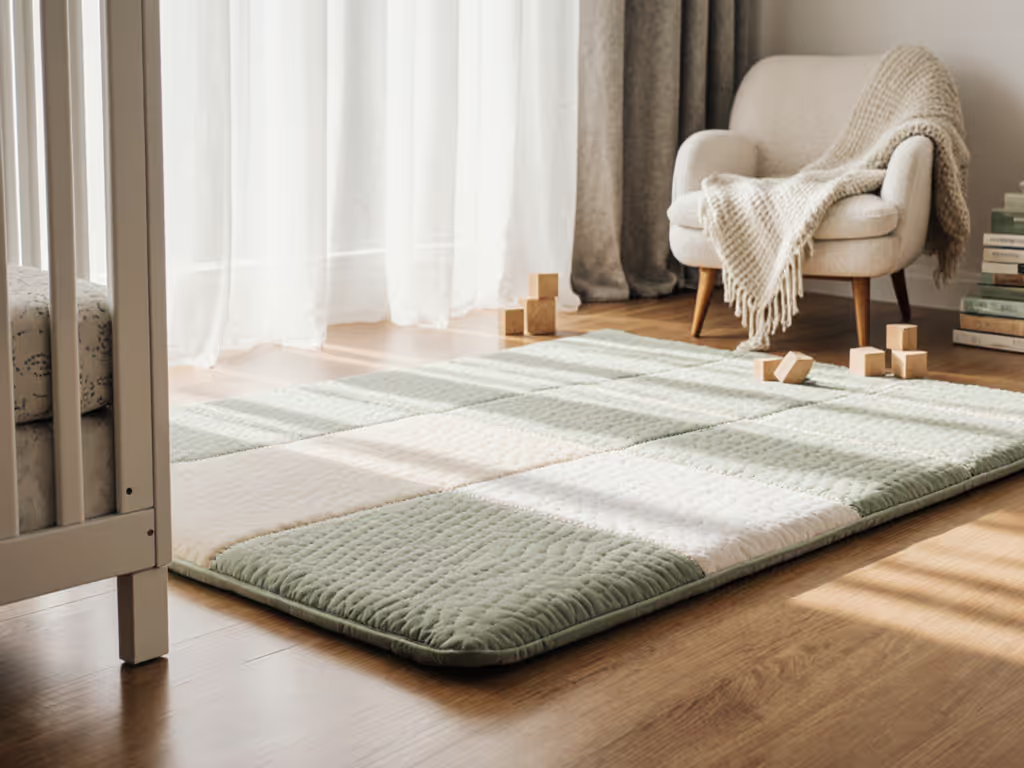
Role of Play Mats: Complete Guide for Safe Play Spaces

Over 80 percent of parents say that creating a safe space for their baby is one of their biggest concerns. When little ones start to move, every corner and hard surface suddenly feels like a risk. The right play mat not only cushions those first tumbles but also supports early learning and development. Understanding the true purpose of play mats helps families choose smarter, safer options for their children’s growth.
Key Takeaways
| Point | Details |
|---|---|
| Safety First | Select play mats that meet safety standards, ensuring they are free from harmful chemicals and non-toxic for children. |
| Developmental Support | Choose mats that promote physical, sensory, and cognitive development, adapting to your child's growth stages. |
| Material Matters | Consider the material of the play mat; different types offer unique benefits in terms of durability, safety, and ease of maintenance. |
| Regular Maintenance | Inspect play mats regularly for signs of wear and tear, and replace them as necessary to maintain a safe play environment. |
Defining Play Mats and Their Core Purpose
Play mats are specialized floor coverings designed to transform ordinary spaces into safe, engaging environments for infants and young children. Safety and developmental support are their primary functions, creating padded surfaces that protect little ones during exploration and play. Unlike traditional floor coverings, these mats serve multiple critical purposes beyond simple floor protection.
At their core, play mats provide a dedicated space where children can move, roll, crawl, and learn without risk of injury from hard surfaces. They feature cushioned materials that absorb impact, reducing potential harm from falls or accidental bumps.
 Ergonomic design means these mats aren't just passive surfaces - they're active tools supporting physical development. From providing traction for emerging crawlers to offering soft landing zones for toddlers learning to walk, play mats become essential developmental companions.
Ergonomic design means these mats aren't just passive surfaces - they're active tools supporting physical development. From providing traction for emerging crawlers to offering soft landing zones for toddlers learning to walk, play mats become essential developmental companions.
Play mats go far beyond basic protection. As research from gym-flooring indicates, they incorporate educational elements that promote cognitive development. Many modern play mats include interactive features like:
- Textured surfaces that stimulate sensory exploration
- Integrated learning patterns or designs
- Color variations that encourage visual tracking
- Attachable toys that promote motor skill development
Choosing the right play mat means understanding your child's specific developmental stage and creating an environment that supports growth. Whether you're preparing a space for a newborn or a curious toddler, these versatile surfaces adapt to changing needs, making them an invaluable investment in your child's early learning journey.
Types of Play Mats and Key Differences
Play mats come in a diverse range of styles, each designed to meet specific developmental needs and spatial requirements. Material composition stands as the primary differentiator, with options ranging from soft foam to durable rubber, each offering unique benefits for children's play environments. Understanding these variations helps parents select the most appropriate mat for their specific situation.
Foam play mats represent the most versatile category, offering cushioned protection and adaptability. These mats typically come in two primary configurations: interlocking puzzle mats and solid foam surfaces. Interlocking designs allow for customizable play spaces that can expand or contract based on room size and child's age. Solid foam mats provide continuous, seamless coverage with enhanced shock absorption, making them ideal for infants learning to move and explore.
Based on research from gym-flooring and accio, play mat varieties include:
- Activity Mats: Featuring built-in interactive toys and sensory elements
- Carpet Mats: Textured surfaces providing tactile stimulation
- Outdoor Playground Mats: Robust designs for exterior use
- Inflatable Mats: Bouncy surfaces for more dynamic play
- Fabric Mats: Lightweight and portable options
Material selection plays a crucial role in determining a play mat's functionality. Rubber mats offer superior durability and slip resistance, vinyl provides easy cleaning, and fabric mats prioritize portability. Each material brings distinct advantages, allowing parents to choose based on their specific home environment, child's age, and intended use. The right play mat transforms an ordinary space into a safe, engaging learning landscape that supports your child's developmental journey.
Essential Safety Standards and Certifications
When it comes to children's play environments, safety standards are not just recommendations—they're critical lifelines protecting our most vulnerable family members. Play mats must undergo rigorous testing and meet specific certifications to ensure they provide a genuinely safe play space. Parents need to understand these standards to make informed purchasing decisions that genuinely protect their children.
Chemical safety emerges as a paramount concern in play mat selection. Research from accio highlights the importance of choosing mats free from harmful substances like BPA and phthalates. Reputable manufacturers now prioritize non-toxic materials that won't release dangerous chemicals during normal use. This commitment means looking beyond surface appearances and investigating the mat's core composition, material sourcing, and manufacturing processes.
Key safety certifications parents should look for include:
- ASTM International Certifications: Ensuring mechanical and material safety standards
- Consumer Product Safety Commission (CPSC) Compliance: Verifying child-specific safety requirements
- Oeko-Tex Standard 100: Confirming textile safety and chemical testing
- EN71 European Safety Standard: Validating toy and child product safety
Beyond chemical concerns, physical safety features are equally crucial. Based on gym-flooring research, high-quality play mats incorporate design elements like anti-slip surfaces, impact-absorbing materials, and seamless construction to prevent potential injury risks. Choosing a play mat isn't just about aesthetics—it's about creating a protective environment where children can explore, learn, and play with minimal risk of accidental harm.

Developmental Benefits for Infants and Toddlers
Play mats are far more than simple floor coverings—they're strategic developmental tools that support critical growth stages for infants and toddlers. Sensory exploration becomes a primary benefit, with specialized surfaces designed to stimulate neural connections and encourage physical movement. These dedicated spaces transform ordinary floor areas into interactive learning environments that adapt to a child's evolving developmental needs.
Physical development represents a significant advantage of high-quality play mats. As research from gym-flooring indicates, these surfaces provide a safe, cushioned space where infants can practice essential motor skills. Gross motor development occurs naturally as babies learn to roll, crawl, and eventually walk on these supportive surfaces. The consistent, predictable texture helps build confidence, allowing children to experiment with movement without fear of hard surfaces or unexpected impacts.
The developmental benefits extend across multiple domains:
- Cognitive Skills: Interactive mat designs encourage problem-solving
- Sensory Processing: Textured surfaces stimulate neural pathways
- Motor Skill Enhancement: Safe environments for movement exploration
- Spatial Awareness: Learning body positioning and movement control
- Social Interaction: Creating engaging play spaces for joint activities
Beyond physical benefits, play mats serve as foundational learning landscapes. They transform mundane floor spaces into rich sensory experiences, supporting language development, spatial reasoning, and early learning concepts. By providing a dedicated, safe environment, these mats become more than accessories—they're essential tools that support holistic childhood development, giving parents a powerful resource for nurturing their child's growth and curiosity.
Common Hazards and Mistakes to Avoid
Parents often underestimate the potential risks associated with seemingly innocent play mats. Safety oversights can transform what should be a protective environment into an unexpected danger zone for curious infants and toddlers. Understanding common hazards is the first step in creating a truly secure play space that supports both exploration and protection.
Material quality stands as a critical consideration in play mat selection. Chemical composition represents a significant risk factor that many parents overlook. Based on gym-flooring research, non-toxic materials with anti-slip surfaces are essential for preventing potential accidents. Cheap, uncertified play mats may contain harmful chemicals like BPA or phthalates that can leach into a child's environment, potentially causing long-term health concerns.
Key hazards and mistakes to watch for include:
- Improper Sizing: Mats with gaps or uneven surfaces that create tripping risks
- Poor Material Quality: Non-certified materials with potential toxic components
- Inadequate Cleaning: Surfaces that harbor bacteria or mold
- Placement Errors: Positioning mats near potential falling hazards
- Age-Inappropriate Designs: Using mats not suited to child's developmental stage
Regular inspection and maintenance are crucial for preventing potential safety issues. Parents should routinely check play mats for signs of wear, such as tears, loose edges, or surface degradation. Remember that a play mat's protective capabilities diminish over time, and what once seemed like a safe surface can become a potential hazard if not properly maintained. Proactive assessment and timely replacement are key to ensuring a consistently safe play environment for your child.
Create a Safe and Stimulating Play Space Your Child Deserves
Choosing the perfect play mat can feel overwhelming when you want the best for your child’s safety and development. This article highlights the important challenges parents face like finding non-toxic materials free from harmful chemicals, avoiding unsafe designs, and ensuring the mat supports physical and cognitive growth. You want a floor covering that offers cushioned protection while encouraging motor skills and sensory exploration in every stage from newborn to toddler.
At FloorBloom, we understand these concerns deeply. Our selection combines rigorous, transparent testing with real-home guidance so you can confidently choose one beautiful, safe, and long-lasting play mat that fits perfectly in your home. Don’t wait until an unsafe mat puts your child at risk or limits their developmental potential. Explore our trusted options at FloorBloom Store and give your little one a play area where they can explore, learn, and grow safely every day.
Start your journey to a secure and enriching play space now by visiting FloorBloom. Your child’s safety and development deserve nothing less.
Frequently Asked Questions
What are play mats and their main purposes?
Play mats are specialized floor coverings designed to create safe, engaging environments for infants and young children. Their primary functions are to provide safety, support development, and transform ordinary spaces into areas where babies can move, roll, crawl, and learn without injury.
What types of play mats are available, and how do they differ?
Play mats come in various types, including foam mats (interlocking or solid), activity mats with interactive toys, carpet mats for tactile stimulation, outdoor playground mats for exterior use, inflatable mats for dynamic play, and fabric mats that are lightweight and portable. Each type has unique benefits tailored to different developmental stages and environments.
What safety standards should I look for when choosing a play mat?
When selecting a play mat, look for safety certifications such as ASTM International Certifications, CPSC Compliance, Oeko-Tex Standard 100, and EN71 European Safety Standard. These certifications ensure the mat meets specific safety requirements for children, including material safety and durability.
How can play mats support my child's development?
Play mats support child development by providing a safe space for sensory exploration, promoting gross motor skills like rolling, crawling, and walking, and enhancing cognitive and social skills through interactive designs. They create a dedicated learning environment that encourages physical movement and supports various developmental domains.
Related Articles


What Are Tested Play Mats? Complete Guide for Families

Complete Guide to the Role of Play Mats

7 Essential Play Mat Features Every Parent Should Know


